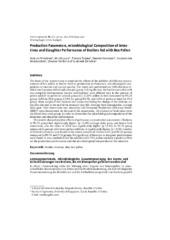Приказ основних података о документу
Production Parameters, microbiological Composition of Intestines and Slaughter Performance of Broilers fed with Bee Pollen
| dc.creator | Petričević, Veselin | |
| dc.creator | Lukić, Miloš | |
| dc.creator | Škrbić, Zdenka | |
| dc.creator | Rakonjac, Simeon | |
| dc.creator | Stanojković, Aleksandar | |
| dc.creator | Nikšić, Dragan | |
| dc.creator | Živković, Vladimir | |
| dc.date.accessioned | 2022-07-02T09:47:29Z | |
| dc.date.available | 2022-07-02T09:47:29Z | |
| dc.date.issued | 2022 | |
| dc.identifier.issn | ISSN 0044-5401 | |
| dc.identifier.uri | http://r.istocar.bg.ac.rs/handle/123456789/788 | |
| dc.description.abstract | The focus of the research was to examine the effects of the addition of different concentrations of bee pollen to broiler feed on production performance, microbiological composition of caecum and carcass quality. The study was performed on 1200 chickens divided into 5 groups with 6 replicates per group. During the test, the broilers were fed with two complete feed mixtures (starter and finisher) each differed only in the amount of pollen added: no pollen in control group (C); 0.25% pollen in feed consumed by P0.25 group; 0.5% in P0.5 group; 0.75% for group P0.75; and 1.0% of pollen in feed for P1.0 group. Body weight of the chickens was measured during the change of the mixture, on the 21st day and at the end of the research (day 42). Average feed consumption, average daily gain, feed conversion rate, mortality and European Production Efficiency Factor (EPEF) were determined. At the end of the experiment, 12 chickens of both sexes were sacrificed from each group, in order to determine the microbiological composition of the intestines and slaughter performance. The results showed positive effects of pollen use on production parameters. Chickens of P0.75 group had significantly higher (p < 0.05) average daily gains and better feed conversion, also the value of EPEF was significantly higher (p < 0.01) in P0.75 group compared to groups with lower pollen addition. A significantly higher (p < 0.01) number of Enterobacteriaceae was found in the cecum content of chickens of C and P0.25 groups compared to P0.75 and P1.0 groups. No significant differences in slaughter performance were found. It was concluded that the addition of 0.75% pollen can have a positive effect on the production performance and the microbiological composition of the intestine. | sr |
| dc.language.iso | en | sr |
| dc.publisher | Verlag Eugen Ulmer, Stuttgart | sr |
| dc.relation | "info:eu-repo/grantAgreement/MESTD/inst-2020/200022/RS//" | sr |
| dc.rights | openAccess | sr |
| dc.rights.uri | https://creativecommons.org/licenses/by/4.0/ | |
| dc.source | Züchtungskunde | sr |
| dc.subject | broiler chickens | sr |
| dc.subject | diet | sr |
| dc.subject | bee pollen | sr |
| dc.title | Production Parameters, microbiological Composition of Intestines and Slaughter Performance of Broilers fed with Bee Pollen | sr |
| dc.type | article | sr |
| dc.rights.license | BY | sr |
| dc.citation.volume | 94 | |
| dc.citation.issue | 1 | |
| dc.citation.spage | 36 | |
| dc.citation.epage | 46 | |
| dc.identifier.rcub | https://hdl.handle.net/21.15107/rcub_ristocar_788 | |
| dc.identifier.fulltext | http://r.istocar.bg.ac.rs/bitstream/id/4050/zueku_2022_01_petricevic_et_al(1).pdf | |
| dc.type.version | publishedVersion | sr |


